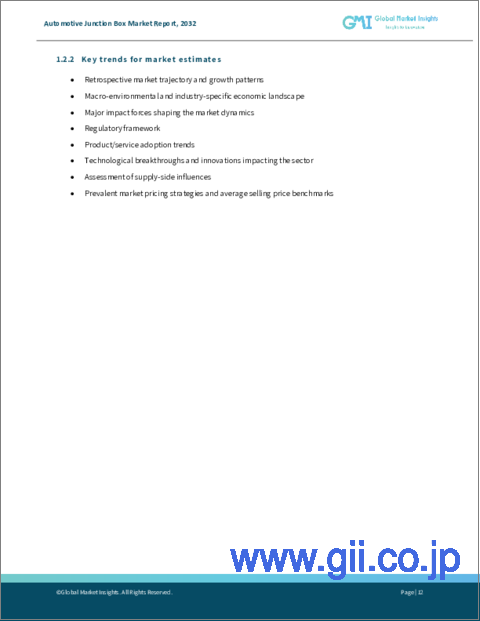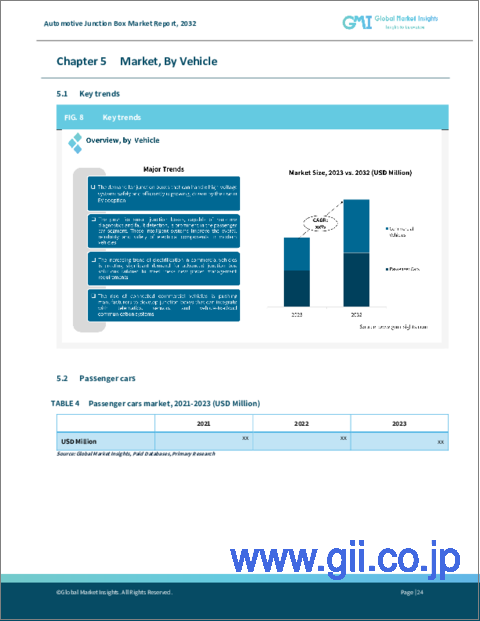|
|
市場調査レポート
商品コード
1621660
自動車用ジャンクションボックスの市場機会、成長促進要因、産業動向分析、2024~2032年予測Automotive Junction Box Market Opportunity, Growth Drivers, Industry Trend Analysis, and Forecast 2024 to 2032 |
||||||
カスタマイズ可能
|
|||||||
| 自動車用ジャンクションボックスの市場機会、成長促進要因、産業動向分析、2024~2032年予測 |
|
出版日: 2024年10月28日
発行: Global Market Insights Inc.
ページ情報: 英文 180 Pages
納期: 2~3営業日
|
全表示
- 概要
- 目次
自動車用ジャンクションボックスの世界市場規模は、2023年に182億米ドルとなり、2024~2032年にかけてCAGR 6.7%で拡大すると予測されています。
電気自動車(EV)へのシフトが進んでいるため、先進的電気システムへの需要が高まっており、ジャンクションボックスは効率的な配電で重要な役割を果たしています。安全規制の強化やADAS(先進運転支援システム)の成長も、電源管理技術の革新を後押ししています。さらに、スマートカーやコネクテッドカー技術の台頭が、より洗練されたジャンクションボックス設計の必要性を高めており、新興国市場での自動車生産台数の増加が、この市場の開拓をさらに後押ししています。ハイブリッドパワートレインの普及は、信頼性の高い電源管理ソリューションの必要性を高めています。
自動車メーカーが電気エンジンと内燃エンジン技術の融合に注力する中、効率的なエネルギー分配のために先進的ジャンクションボックスが不可欠になりつつあり、それが最終的に車両性能を高めることになります。燃費向上と低排出ガスを求める消費者の需要も自動車用電装部品の進歩に拍車をかけており、メーカーはハイブリッド車や完全電気自動車のエネルギーフローの最適化にますます注力しています。タイプ別に見ると、市場はパッシブジャンクションボックスとスマートジャンクションボックスなどに分けられます。2023年に市場シェアの49%を占めたパッシブジャンクションボックスは、2032年までに137億米ドル以上に達すると予測されています。これらのジャンクションボックスは、そのコスト効率と信頼性により、従来の自動車モデルで人気を保っています。
スマートジャンクションボックスほど先進的ではないが、パッシブタイプは基本的な機能を効果的にサポートするために適応されつつあり、幅広い従来型車両に対応し、メーカーは電気システムを合理化できます。車両カテゴリーに関しては、自動車用ジャンクションボックス市場は乗用車と商用車に分けられます。乗用車は2023年の市場で71%の圧倒的シェアを占めています。先進的電力管理を必要とする電気自動車やハイブリッド乗用車モデルに対する消費者の関心の高まりが大きな推進力となっています。さらに、乗用車へのADASやコネクテッド機能の搭載が、スマートジャンクションボックスの需要増につながっています。
| 市場範囲 | |
|---|---|
| 開始年 | 2023年 |
| 予測年 | 2024~2032年 |
| 開始金額 | 182億米ドル |
| 予測金額 | 324億米ドル |
| CAGR | 6.7% |
安全性と利便性は依然として消費者の最優先事項であり、メーカーは進化するニーズに対応するために電気システムアーキテクチャの革新を続けています。アジア太平洋は、2023年の売上シェアの36%以上を占めて市場をリードし、2032年には123億米ドルを超えると予測されます。中国では電気自動車の急速な普及が大きな要因となっており、先進的配電ソリューションに対する需要が高まっています。EVに対する政府の強力な支援と国内自動車メーカーの活動拡大が相まって、この地域におけるインテリジェントな自動車用エレクトロニクスへのシフトが加速しています。自律走行車やコネクテッドカー技術への投資が増加していることから、中国は次世代自動車用電気システムのリーダーとして位置づけられ、継続的な市場成長の舞台となっています。
目次
第1章 調査手法と調査範囲
第2章 エグゼクティブサマリー
第3章 産業洞察
- エコシステム分析
- サプライヤーの状況
- 原料サプライヤー
- 部品メーカー
- ジャンクションボックスメーカー
- OEMメーカー
- アフターマーケットサプライヤー
- 流通チャネル
- エンドユーザー
- 利益率分析
- 技術革新の状況
- 主要ニュース
- 規制状況
- 技術の差別化要因
- スマートジャンクションボックス
- パッシブ・ジャンクションボックス
- ADASとの統合
- 影響要因
- 促進要因
- 電気自動車の採用増加
- ADAS(先進運転支援システム)の需要拡大
- スマートビークル技術と接続性の拡大
- 軽量・コンパクトな自動車部品へのシフト
- 産業の潜在的リスク・課題
- 車両電気アーキテクチャの複雑化
- 多数の市場参入企業による高い競合
- 促進要因
- 成長可能性分析
- ポーター分析
- PESTEL分析
第4章 競合情勢
- イントロダクション
- 企業シェア分析
- 競合のポジショニングマトリックス
- 戦略展望マトリックス
第5章 市場推定・予測:タイプ別、2021~2032年
- 主要動向
- パッシブ
- スマート
- その他
第6章 市場推定・予測:機能別、2021~2032年
- 主要動向
- 自動車用パワースイッチング
- 車体制御
第7章 市場推定・予測:流通チャネル別、2021~2032年
- 主要動向
- OEM
- アフターマーケット
第8章 市場推定・予測:車種別、2021~2032年
- 主要動向
- 乗用車
- ハッチバック
- セダン
- SUV
- 商用車
- LCV
- HCV
第9章 市場推定・予測:地域別、2021~2032年
- 主要動向
- 北米
- 米国
- カナダ
- 欧州
- 英国
- ドイツ
- フランス
- スペイン
- イタリア
- ロシア
- 北欧
- アジア太平洋
- 中国
- インド
- 日本
- 韓国
- ニュージーランド
- 東南アジア
- ラテンアメリカ
- ブラジル
- メキシコ
- アルゼンチン
- 中東・アフリカ
- アラブ首長国連邦
- 南アフリカ
- サウジアラビア
第10章 企業プロファイル
- Aptiv
- BorgWarner
- Bosch
- Continental
- Denso
- Eaton
- Furukawa Electric
- Hilite International
- Johnson Control
- Lear Corporation
- Mechadyne International
- Mitsubishi Industrial Automation
- Nexans Autoelectric
- ON Semiconductor
- Panasonic
- PKC Group
- Schaeffler Technologies
- Sumitomo Electric
- Valeo
- Yazaki
The Global Automotive Junction Box Market was valued at USD 18.2 billion in 2023 and is expected to expand at 6.7% CAGR from 2024 to 2032. The increasing shift towards electric vehicles (EVs) is fueling the demand for advanced electrical systems, with junction boxes playing a key role in efficient power distribution. Stricter safety regulations and the growth of advanced driver assistance systems (ADAS) are also pushing innovation in power management technologies. Additionally, the rise of smart and connected vehicle technologies is driving the need for more sophisticated junction box designs, while rising vehicle production in emerging markets further supports this market's development. The widespread adoption of hybrid powertrains amplifies the need for reliable power management solutions.
As automakers focus on combining electric and internal combustion engine technology, advanced junction boxes are becoming essential for effective energy distribution, which ultimately enhances vehicle performance. Consumer demand for greater fuel efficiency and lower emissions is also spurring advancements in automotive electrical components, with manufacturers increasingly focused on optimizing energy flow in hybrid and fully electric vehicles. In terms of type, the market is divided into passive and smart junction boxes, among others. Passive junction boxes, which accounted for 49% of the market share in 2023, are projected to reach over USD 13.7 billion by 2032. These junction boxes remain popular in traditional vehicle models due to their cost-efficiency and dependability.
While they are not as advanced as smart junction boxes, passive types are being adapted to support basic functionalities effectively, catering to a broad range of conventional vehicles and allowing manufacturers to streamline electrical systems. Regarding vehicle categories, the automotive junction box market is divided into passenger cars and commercial vehicles. Passenger cars held a dominant 71% share of the market in 2023. Growing consumer interest in electric and hybrid passenger models, which require sophisticated power management, is a significant driver. Additionally, the incorporation of ADAS and connected features in passenger vehicles is leading to a higher demand for smart junction boxes.
| Market Scope | |
|---|---|
| Start Year | 2023 |
| Forecast Year | 2024-2032 |
| Start Value | $18.2 Billion |
| Forecast Value | $32.4 Billion |
| CAGR | 6.7% |
Safety and convenience remain top priorities for consumers, encouraging manufacturers to continue innovating in electrical system architecture to meet evolving needs. The Asia Pacific region led the market with over 36% of the revenue share in 2023, projected to surpass USD 12.3 billion by 2032. China's rapid adoption of electric vehicles is a major factor, as the country sees increased demand for advanced power distribution solutions. Strong government support for EVs, combined with expanding domestic automaker activity, accelerates the shift towards intelligent automotive electronics in the region. Rising investment in autonomous and connected vehicle technologies positions China as a leader in next-generation automotive electrical systems, setting the stage for continued market growth.
Table of Contents
Chapter 1 Methodology & Scope
- 1.1 Research design
- 1.1.1 Research approach
- 1.1.2 Data collection methods
- 1.2 Base estimates and calculations
- 1.2.1 Base year calculation
- 1.2.2 Key trends for market estimates
- 1.3 Forecast model
- 1.4 Primary research & validation
- 1.4.1 Primary sources
- 1.4.2 Data mining sources
- 1.5 Market definitions
Chapter 2 Executive Summary
- 2.1 Industry 360° synopsis, 2021 - 2032
Chapter 3 Industry Insights
- 3.1 Industry ecosystem analysis
- 3.2 Supplier landscape
- 3.2.1 Raw material suppliers
- 3.2.2 Component manufacturers
- 3.2.3 Junction box manufacturers
- 3.2.4 OEMs
- 3.2.5 Aftermarket suppliers
- 3.2.6 Distribution channels
- 3.2.7 End users
- 3.3 Profit margin analysis
- 3.4 Technology & innovation landscape
- 3.5 Key news & initiatives
- 3.6 Regulatory landscape
- 3.7 Technology differentiators
- 3.7.1 Smart junction boxes
- 3.7.2 Passive junction boxes
- 3.7.3 Integration with ADAS
- 3.8 Impact forces
- 3.8.1 Growth drivers
- 3.8.1.1 Increasing adoption of electric vehicles
- 3.8.1.2 Growing demand for advanced driver assistance systems
- 3.8.1.3 Expansion of smart vehicle technologies and connectivity
- 3.8.1.4 Shift towards lightweight and compact automotive components
- 3.8.2 Industry pitfalls & challenges
- 3.8.2.1 Increasing complexity in vehicle electrical architectures
- 3.8.2.2 High competition among numerous market players
- 3.8.1 Growth drivers
- 3.9 Growth potential analysis
- 3.10 Porter's analysis
- 3.11 PESTEL analysis
Chapter 4 Competitive Landscape, 2023
- 4.1 Introduction
- 4.2 Company market share analysis
- 4.3 Competitive positioning matrix
- 4.4 Strategic outlook matrix
Chapter 5 Market Estimates & Forecast, By Type, 2021 - 2032 ($Bn, Units)
- 5.1 Key trends
- 5.2 Passive
- 5.3 Smart
- 5.4 Others
Chapter 6 Market Estimates & Forecast, By Function, 2021 - 2032 ($Bn, Units)
- 6.1 Key trends
- 6.2 Automotive power switching
- 6.3 Vehicle body control
Chapter 7 Market Estimates & Forecast, By Sales Channel, 2021 - 2032 ($Bn, Units)
- 7.1 Key trends
- 7.2 OEM
- 7.3 Aftermarket
Chapter 8 Market Estimates & Forecast, By Vehicle, 2021 - 2032 ($Bn, Units)
- 8.1 Key trends
- 8.2 Passenger cars
- 8.2.1 Hatchback
- 8.2.2 Sedan
- 8.2.3 SUV
- 8.3 Commercial vehicles
- 8.3.1 LCV
- 8.3.2 HCV
Chapter 9 Market Estimates & Forecast, By Region, 2021 - 2032 ($Bn, Units)
- 9.1 Key trends
- 9.2 North America
- 9.2.1 U.S.
- 9.2.2 Canada
- 9.3 Europe
- 9.3.1 UK
- 9.3.2 Germany
- 9.3.3 France
- 9.3.4 Spain
- 9.3.5 Italy
- 9.3.6 Russia
- 9.3.7 Nordics
- 9.4 Asia Pacific
- 9.4.1 China
- 9.4.2 India
- 9.4.3 Japan
- 9.4.4 South Korea
- 9.4.5 ANZ
- 9.4.6 Southeast Asia
- 9.5 Latin America
- 9.5.1 Brazil
- 9.5.2 Mexico
- 9.5.3 Argentina
- 9.6 MEA
- 9.6.1 UAE
- 9.6.2 South Africa
- 9.6.3 Saudi Arabia
Chapter 10 Company Profiles
- 10.1 Aptiv
- 10.2 BorgWarner
- 10.3 Bosch
- 10.4 Continental
- 10.5 Denso
- 10.6 Eaton
- 10.7 Furukawa Electric
- 10.8 Hilite International
- 10.9 Johnson Control
- 10.10 Lear Corporation
- 10.11 Mechadyne International
- 10.12 Mitsubishi Industrial Automation
- 10.13 Nexans Autoelectric
- 10.14 ON Semiconductor
- 10.15 Panasonic
- 10.16 PKC Group
- 10.17 Schaeffler Technologies
- 10.18 Sumitomo Electric
- 10.19 Valeo
- 10.20 Yazaki





